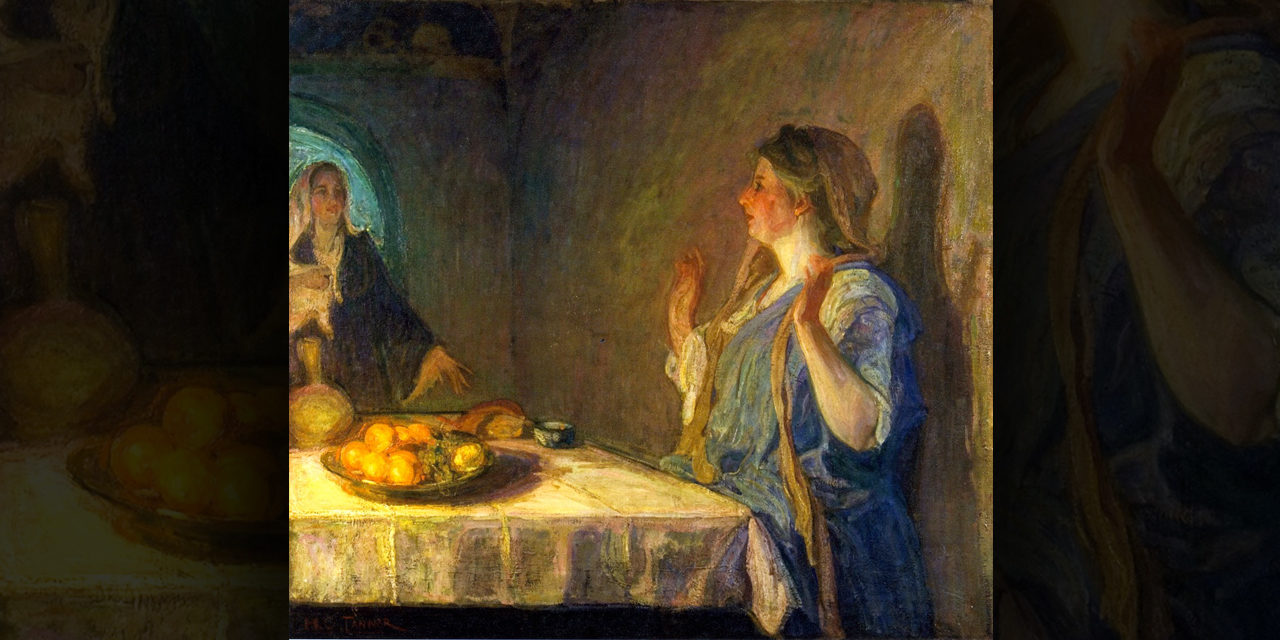Credit: Henry Ossawa Tanner, The Visitation, 1910
If quizzed “Who was the first person to welcome Jesus and announce His Lordship?” how would you answer?
It’s an important question when we consider that this man from the nowhere town of Nazareth is the most consequential individual to ever be born. His teaching and followers across the globe would radically transform world culture, topple great powers without ever firing a shot, establish the world of humanitarianism, accessible medical care for commoners, develop the scientific method and enliven world-wide movements for justice, human dignity and individual freedom. He would literally divide history, and be responsible for the founding of the largest, most diverse collection of people around some basic ideals that would become Christendom.
We must appreciate that all of this started with two very simple women that no one had ever heard of.
Mary, a humble young virgin, by tradition about 14 years old, is told by an angel she would give birth to the very Son of God. At this striking news, we are told she “arose and went with haste” to go see her cherished relative Elizabeth, some 90 miles away. Elizabeth was in the 6th month of her own miraculous pregnancy, her womb having closed for business loooong before. Of course, her baby was Jesus’ cousin, John the Baptist.
The beauty of this part of the Christmas story, and the answer to our original question, is the miracle that happens at the very moment Mary enters Elizabeth’s home. Christ, in utero, is recognized, received, proclaimed and worshiped, and Mary and Elizabeth are not the only ones involved in the divine drama here. We read in Luke 1:41-44…
And when Elizabeth heard the greeting of Mary, the baby leaped in her womb.
And Elizabeth was filled with the Holy Spirit, and she exclaimed with a loud cry, “Blessed are you among women, and blessed is the fruit of your womb! And why is this granted to me that the mother of my Lord should come to me?
For behold, when the sound of your greeting came to my ears, the baby in my womb leaped for joy.
Catch that last statement from Elizabeth: “The baby in my womb leaped for joy.”
This is a MAJOR event in Jesus’ story and thus the Christian Church, but we seldom appreciate it for what it actually is. It is the first time that Jesus is both proclaimed and worshiped as God! And this was done, we are told, “in a loud voice.” And Christ the Lord is worshiped by two people at the same time. One very old, one super young.
First to Proclaim Jesus’ Lordship
Elizabeth proclaims the blessedness of Jesus and His mother. Elizabeth is the first one to recognize and proclaim Jesus as her Lord. The simple but world-changing confession, “Jesus is Lord,” was the first and most basic way that Christians began to proclaim their faith and greet one in the Church’s early years. It was the first Christian creed and Elizabeth was the first to proclaim it, long before Christmas morning. Think on that for a moment.
The second greeting is even more incredible and speaks to a very intimate relationship in the Savior’s life. Baby John leaps for joy, literally, at the coming of the Savior. He does so as a child in the darkness of his mother’s womb. (Yes, Christianity has profoundly strong words for the humanity and dignity of the unborn child in John and Jesus’ remarkable in utero contribution to the Good News.)
John did not start serving as the forerunner of Christ when preaching about His coming in the desert. It was here, in the womb. And it was two very common mothers, Elizabeth and Mary, who were the only ones able to experience this remarkable, history-changing event. It happened in the distinctly womanly interiors of their hearts and wombs in the humbleness of Elizabeth’s home.
Humble motherhood, and the intimate bond that only mothers can share, is the human font of the Christian story. To be sure, the Christian Church, which is often incorrectly charged with being sexist by people who know little of its actual story, is founded upon two women being the first to welcome and praise the Savior. (Remember as well, it was a small group of women who announced the “second birth” of the Savior, if you will, at His resurrection.) What other major faith or philosophy has women playing such a significant role in its founding? I cannot think of one.
This divine interchange between these two women in this domestic setting is unspeakably profound. And we typically move over it far too easily, wanting to get onto what we see as the center of the Christmas story, the manger. But this drama is also vitally important because it is the first revelation of Christ beyond Mary’s own heart and womb.
Just consider this. The Visitation, as it is known, is the precise second and scene of the commencement of the worship of the very Son of the God that will continue without end into eternity, the very purpose of history itself.
And it started with two mothers and their unborn children.
The Daily Citizen has a companion Christmas commentary on Joseph and the power of fatherhood here.
Photo from Wiki Art






